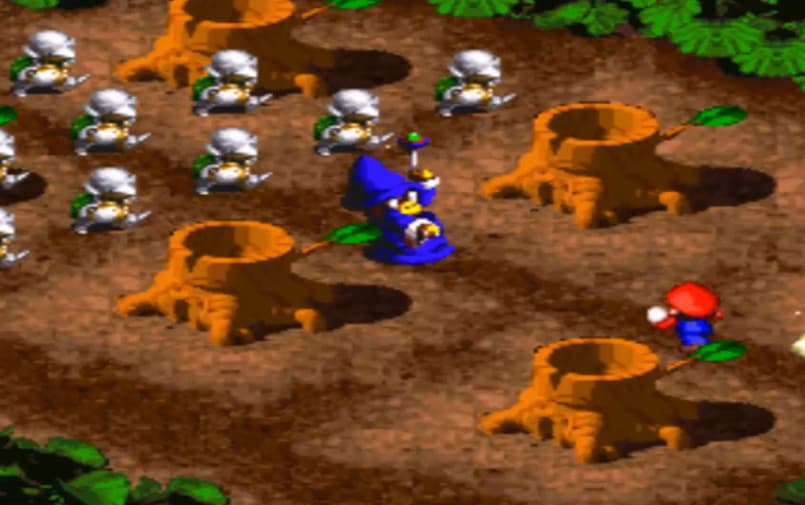
A Throwback to Mario’s Forgotten RPG
Nintendo’s first ever Super Mario that existed outside the platforming genre was released in 1996, called Super Mario RPG: The Legend of the Seven Stars. The game was developed by Square, who integrated other RPG elements that are still popular in the genre today. Turn-based combat was the largest of these adoptions that they included, which was a significant change up from the previously established playstyle of the Mario franchise.
I never even heard about this RPG until Nintendo offered classic games on the Wii marketplace for less than $5. It quickly became one of my favorites of all time, and I still devour any RPG in the Mario series.
Not only did Square change Mario’s preestablished gameplay, but they also switched up the classic “Defeat Bowser and rescue princess” story just a bit. The focus of this quest is to defeat Smithy, a giant robotic blacksmith that looks distinctly like a sword and to find all seven star pieces to help maintain order.
Mario and co. must travel through the world of the Mushroom Kingdom, adding a few new places to the roster, including Rose Town, Bowser’s Castle, and Nimbus Land, divided into seven different worlds. Mario and his team must find all of the pieces, finish an epic boss battle with Smithy and his gang, and regain control of the kingdom. Pretty straight forward, but an amazing twist on what was the current Mario style.
Super Mario RPG has Mario moving through the world, battling enemies, searching the landscape for secrets and items to pick up, and adventuring across the world in search of your treasure. Like many RPGs of this era, there are enemy encounters. Enemies will traverse each of the worlds, allowing you to either run head first into battle and gain an advantage or to avoid them altogether.
Because of this, players can play as stealthy as they’d like or just run headfirst into everything, but there is a trade-off. Too many encounters can leave you weak and without status items, but stealth can leave you under leveled and weak against the bosses. More than once, you’ll have to restart from your last save point because you were leaning too far in one direction and need to restrategize.
Another wonderful aspect that Square leaned into is the idea of having a changeable party. With the turn-based combat, it helps to offer the player a heavy hitter, a healer or two, and a well-balanced character. As far as battles go, characters can deal physical or magic damage, respectively, with each character having their own stats, which can increase as they gain exp. You gain each one as the story progresses, so you will end up playing with each character for a while and may develop a favorite, either narrative or gameplay wise.
Mario can have a total of three characters in his party, with five choices. The first is Mario. He’s generally the well-balanced pick of the lot and the only required member. He has average strength in his hits, by either jumping or throwing his hammer. For healing, you have Mallow and Princess Peach. While Mallow is better for elemental magic than anything else, Peach is a powerhouse, dealing better healing, but is overall weak on physical attacks.
Both Geno and Bowser are the heavy hitters of the group, with Bowser being overwhelmingly the strongest, but Geno is the fastest and with the ability to buff himself and others. These characters all make sense and feel natural during gameplay. Switching them out can alter the strategy you use for different enemies or boss battles.
Because of the characters at your disposal and your ability to strategize each fight, this RPG has a little bit more playability than, say, a platformer, which sticks to the rails pretty much always. The subtle changes in the party members abilities can give the game a new life on the second or third playthroughs.
While the story is pretty wacky, it maintains a relaxed and jovial feel that doesn’t feel too outdated today if you aren’t too serious. I would definitely say that this game has some replayability, even over 20 years on. Play this game at least once, and then again, switching things up and trying to find all the secrets lovingly hidden throughout the game.
Super Mario RPG: Legend of the Seven Stars was released to positive reviews, being noted as a great game on every level. It’s easy to see why — the game was fresh for a franchise that had been held up a shining beacon for platforming games. Super Mario RPG proved that Mario could hold his own in the role-playing circuit. It doesn’t matter if you’re a fan of Nintendo or just a lover of RPG games, this is definitely a game that you should find and play.
